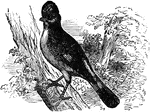Clipart tagged: ‘Garrulus glandarius’

Eurasian Jay
"European Jay. Garrulus glandarius. With the wings much shorter than or about equalling the tail, both…

"European Jay. Garrulus glandarius. With the wings much shorter than or about equalling the tail, both…